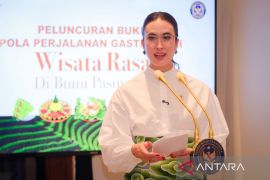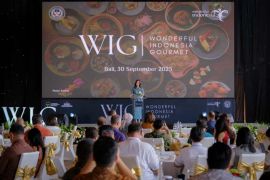The kitchen's classic atmosphere "transports" visitors back to Bali's nostalgic old times.
Traditional wooden doors with Bali's iconic carvings placed in several spots and other wooden decorations lend natural and artistic vibes to the kitchen, which was established in 2021.
The restaurant's concept seeks to highlight Les village as an old village in Northern Bali that needs to be preserved.
The restaurant is in the form of a hall and has been designed as a place where visitors can relax while dining.
Gede Yudiawan, the owner of the restaurant, is directly involved in cooking the restaurant's spice-heavy foods.
The 43-year-old is no ordinary restauranter. He has worked with renowned Indonesian culinary expert William Wongso on some projects in Indonesia and abroad.
It is no wonder then that Yudiawan has retained the title of chef even after his previous restaurant Badung District shuttered its doors due to the COVID-19 pandemic.
A traditional kitchen
Moela Balinese Kitchen is situated on the beach and mostly offers Balinese seafood.
What is unique is that the kitchen has no fixed menu and drums up dishes based on the fishermen’s daily catch from the village.
Mostly, the restaurant gets marine products in the form of fish, octopuses, and squids, and immediately processes them.
Thus, customers need to make their order online one to two days before their visit so that the restaurant can prep the food ingredients.
The chef, who has three children, processes the marine products first-hand using typical Bali herbs and spices that he sources from surrounding villages.
Dressed in a white koko shirt, his hands deftly slice fish with a specially designed and sharp knife.
Occasionally, he wipes the sweat off his face with a towel slung over his shoulder, while smoke billowing from the paon, a traditional kitchen, envelops him.
Most of the dishes are cooked using traditional methods, for instance, furnace and firewood are used to grill satay (Indonesian grilled meat), cook rice, and process fish.
As for the firewood, Yudiawan can easily collect it from his garden and several spots around the village.
All the while, customers can directly witness the cooking process and soak in the typical aroma of the traditional kitchen.
Chef Yudiawan and his six assistants cook the restaurant's featured dishes, such as timbungan fish (a bamboo-baked fish gravy), lilit (wrapped) satay, fish satay, and a preparation made from grated coconut, octopus, vegetables, Bali spices, and long pepper called lawar octopus.
Voluntary pricing
What makes the restaurant even more interesting is voluntary pricing: customers can pay whatever they want for their meal.
Chef Yudiawan describes the payment as a donation and says it does not feel like a loss.
"I cook what I can cook and people pay with the price they can afford. If I set a price, they will have high expectations. I want freedom in developing potentials in the village," Yudiawan told ANTARA.
His philosophy is in line with his other role as a pemangku, a Hindu priest who serves congregations at the temples in Les and Penuktukan villages in the Buleleng district.
To fulfill his religious role, he often needs to close the restaurant to serve the people during major religious ceremonies in the villages.
However, it is this uniqueness that appeals to people who come to his restaurant to taste his preparations.
Regina, a customer from Denpasar, willingly took a long trip for the sake of the restaurant’s unique experience.
She said she first came to know about the restaurant from her friends' posts on social media.
"I was extremely curious so I take my family to visit and it turned out that the foods were greatly delicious. I would love to revisit this kitchen," she said.
After their meal, Regina and her family proceeded to put Rp100 thousand (US$6.65) bills into a jar marked "donation."
The restaurant's unique concept also attracted Buwana Marhenta, a college student, who based his research for his thesis on it.
During his month-long research, the student explored the relationship between customers' experience and satisfaction and the donation payment method.
Gastronomic tourism
In addition to food, the restaurant also produces traditionally processed brown sugar.
On average, the restaurant produces up to 10 liters of brown sugar per day using about 100 liters of palm tree sap.
Furthermore, the kitchen produces arak, a traditional liquor made from doub palm sap, which is boiled in a furnace using firewood. The resultant steam is then passed through bamboo and the liquor is collected and stored in bottles.
The restaurant’s average arak production per day is 24 bottles, each of which contains up to 750 milliliters of liquor, or some 18 liters in total.
According to the head of I Love Indonesian Foods Community (ACMI), Santhi Serad, not every business actor dares to apply the restaurant's unique concept and voluntary pricing.
Apart from exploring potentials in the village and preserving culture, the concept also introduces gastronomic tourism as a type of tourism that is not yet widely known among the public, she added.
The scope of gastronomic tourism is broader than culinary tourism, which simply focuses on the sampling of typical foods in certain places, Serad elaborated.
In addition to tasting foods, she said, gastronomic tourism offers indirect storytelling to visitors through the explanation of the foods' ingredients and history.
Hence, visitors can learn about additional values connected to the foods they try.
"In gastronomic tourism, a visitor comes to a place not only to taste the food but also to learn its story," Serad said.
Related news: Year of Culture: Qatari chefs participate in Balinese megibung
Translator: Dewa Ketut, Tegar Nurfitra
Editor: Bayu Prasetyo
Copyright © ANTARA 2023












